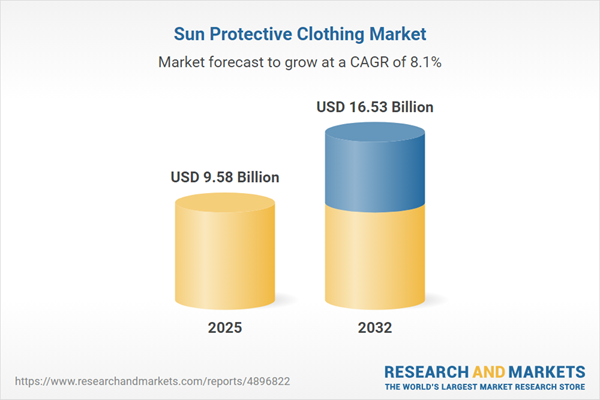Speak directly to the analyst to clarify any post sales queries you may have.
Senior decision-makers are navigating a dynamic sun protective clothing market, driven by emerging regulations, evolving consumer expectations, and sustainability imperatives. Strategic agility, robust compliance, and continuous innovation are all essential for organizations aiming to secure and maintain a leading position within this evolving sector.
Market Snapshot: Sun Protective Clothing Market Overview
The sun protective clothing market is characterized by robust expansion and a notable compound annual growth rate.
Market progress is fueled by heightened awareness of skin health, advances in ultraviolet protection standards, and significant momentum in sustainable textile development. Stakeholders are recalibrating business models to remain competitive, aligning procurement processes with both updated consumer expectations and shifting regulatory frameworks. The integration of strategic, operational, and technological initiatives, especially those anchored in sustainability, positions businesses to build durable advantages in a changing landscape.Scope & Segmentation of the Sun Protective Clothing Market
- Product Types: Includes hats, shirts, pants, gloves, scarves, and various swimwear designed for day-to-day, performance-driven, and professional use. Options support broad audiences and niche markets seeking reliable protection.
- Fabric Materials: Features range from breathable cotton blends for regular comfort, advanced synthetics for moisture management, to antibacterial wool ensuring durability and hygiene in diverse use scenarios.
- UPF Levels: Products span standard to acute protection against ultraviolet exposure, enabling compliance with workplace health and safety standards and catering to different environmental or occupational exposures.
- Distribution Channels: Department stores, specialty retailers, prominent e-commerce platforms, and direct manufacturer relationships allow for adaptable supply strategies suited to a range of business models.
- End Users: Solutions are tailored for men’s and women’s protective requirements across athletic, professional, and leisure segments, with increasing emphasis on customization and user-specific risk mitigation.
- Regional Markets: North America, South America, Europe, the Middle East, Africa, and Asia-Pacific each present unique demand drivers, influenced by local climate, compliance needs, and urbanization patterns. Asia-Pacific shows notable market acceleration, while North America and Europe remain focal points for product innovation.
Key Takeaways for Senior Decision-Makers
- The adoption of bio-based fibers and nanotechnology supports both product innovation and environmental objectives, opening fresh segments in both established and developing markets.
- Increased supply chain transparency prompts procurement teams to align sourcing with updated labeling regulations and sustainability-focused initiatives, enhancing stakeholder trust.
- Advancements in product performance such as moisture management, adaptive climate control, and ultraviolet detection are setting higher standards in end-user protection and differentiation.
- The implementation of digital procurement and predictive analytics streamlines supply forecasting, boosting operational agility and reducing the impact of market fluctuations.
- Regional distinctions, especially across Asia-Pacific and the Americas, require flexible product designs and advanced technical features suited to varied regulatory and environmental contexts.
Tariff Impact on Supply Chains and Sourcing
Shifts in U.S. tariff policy are introducing further complexity into sun protective clothing supply chains. Executives are proactively reassessing sourcing patterns, weighing offshore and nearshore alternatives to ensure consistent operations. Utilizing predictive analytics minimizes potential disruptions and strengthens supply chain sustainability while maintaining continuity.
Methodology & Data Sources
This report draws on detailed interviews with senior executives, insights from textile science and dermatology experts, and comprehensive industry surveys. Ongoing regulatory analysis and feedback from procurement and supply stakeholders provide a reliable foundation for forward-looking, strategic recommendations.
Why This Report Matters
- Supports confident investment and innovation decisions by clarifying shifting market regulations and evolving regional dynamics within the sun protective clothing sector.
- Delivers actionable insights to help procurement teams optimize supply management, manage risk, and advance organizational sustainability benchmarks.
- Prepares senior executives to shape resilient strategies responsive to new technologies and anticipated regulatory or consumer-driven market changes.
Conclusion
Proactive, collaborative strategies—grounded in compliance and innovation—will be essential for ongoing success in the sun protective clothing market. Engagement with stakeholders and sustained regulatory vigilance support long-term resilience and growth.
Additional Product Information:
- Purchase of this report includes 1 year online access with quarterly updates.
- This report can be updated on request. Please contact our Customer Experience team using the Ask a Question widget on our website.
Table of Contents
3. Executive Summary
4. Market Overview
7. Cumulative Impact of Artificial Intelligence 2025
Companies Mentioned
The companies profiled in this Sun Protective Clothing market report include:- Columbia Sportswear Company
- UNIQLO Co., Ltd.
- H&M Hennes & Mauritz AB
- Coolibar, LLC
- Marks and Spencer Group PLC
- Patagonia, Inc.
- REI Cooperative
- UV Skinz, LLC
- Jan & Jul Inc.
Table Information
| Report Attribute | Details |
|---|---|
| No. of Pages | 188 |
| Published | November 2025 |
| Forecast Period | 2025 - 2032 |
| Estimated Market Value ( USD | $ 9.58 Billion |
| Forecasted Market Value ( USD | $ 16.53 Billion |
| Compound Annual Growth Rate | 8.1% |
| Regions Covered | Global |
| No. of Companies Mentioned | 10 |









